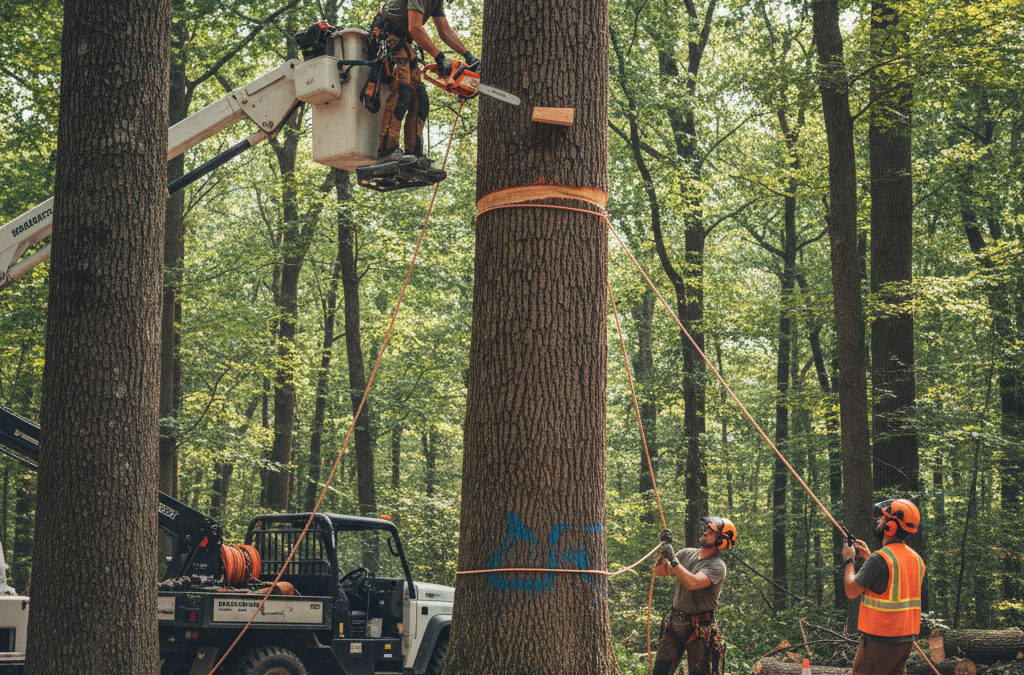Cutting large trees is a challenging and potentially dangerous task. Without the right techniques and safety measures, it can result in property damage, personal injury, or even fatalities.
That’s why professional tree service companies carefully select methods that prioritize safety while efficiently removing large trees from your property.
Understanding safe cutting methods is essential for homeowners considering tree removal. Large trees require more planning, specialized equipment, and experienced personnel to ensure the process is controlled and predictable.
Employing the right techniques not only protects people and property but also preserves surrounding landscaping and infrastructure.
Sectional Removal (Dismantling from the Top Down)
One of the safest methods for large tree removal is sectional removal, where the tree is cut in manageable pieces.
- Remove branches and limbs from the top first, guiding them safely to the ground.
- Cut the trunk in segments to control the fall and weight of each piece.
- Plan escape routes for workers in case of unexpected shifts.
Sectional removal reduces the risk of uncontrolled falls and allows work in tight spaces. Professionals carefully manage each cut to protect property and bystanders.
Rigging Techniques
Rigging involves using ropes, cables, and pulleys to control how branches and trunk sections fall.
- Attach rigging ropes to large limbs for controlled lowering.
- Use pulleys or cranes to guide heavy pieces safely to the ground.
- Ensure rigging points are secure and inspected before every cut.
Rigging provides precision and control, particularly for trees near buildings, power lines, or other obstacles. This technique reduces damage and keeps the worksite safe for everyone.
Using Proper Equipment
Large tree removal requires specialized tools to handle size and weight safely.
- Chainsaws with adequate bar length and power for large cuts.
- Pole saws or extended reach tools for high branches.
- Cranes or aerial lifts for extremely tall or unstable trees.
Using the correct equipment ensures cuts are accurate and reduces the risk of accidents. Professionals select tools based on tree species, height, and location to maintain safety.
Pruning Before Removal
Sometimes, trimming or pruning sections before removing the main trunk enhances safety.
- Remove weak, broken, or hazardous limbs first.
- Thin excessive foliage to improve visibility and reduce weight on remaining branches.
- Shape the tree strategically to prevent unexpected movement during removal.
Pre-removal pruning makes large trees more manageable and reduces the chance of dangerous swings or drops. It also ensures the tree’s removal is controlled and predictable.
Following Safety Protocols and Planning
Even the best techniques require strict safety protocols and strategic planning.
- Conduct a thorough site assessment before starting work.
- Establish clear communication and signals among the crew.
- Ensure all workers wear personal protective equipment, including helmets, gloves, and eye protection.
Safety planning minimizes the risk of injury and property damage during every stage of removal. Professionals combine technical methods with careful oversight to execute large tree removals efficiently.
Safe Methods Protect Your Home and Landscape
Cutting large trees is inherently risky, but the right methods can make the process safe and efficient. Sectional removal, rigging, proper equipment, pre-removal pruning, and strict safety planning all contribute to a controlled and hazard-free removal.
By hiring professional tree service companies that follow these protocols, homeowners ensure the safety of their property, family, and landscape. Proper techniques not only prevent accidents but also maintain the integrity of surrounding areas, delivering peace of mind along with professional results.

